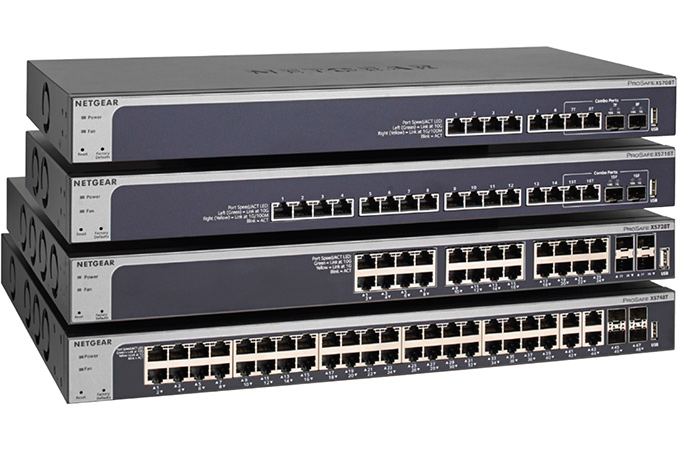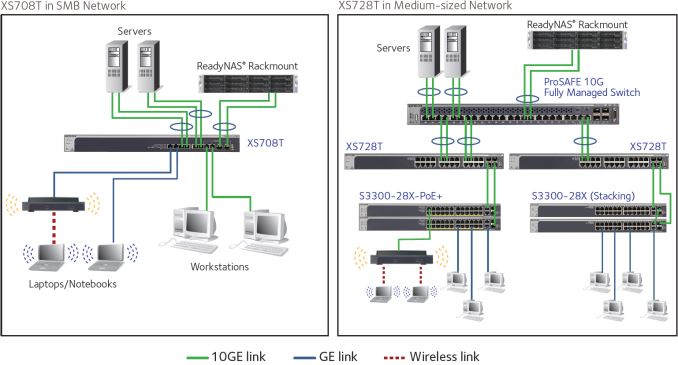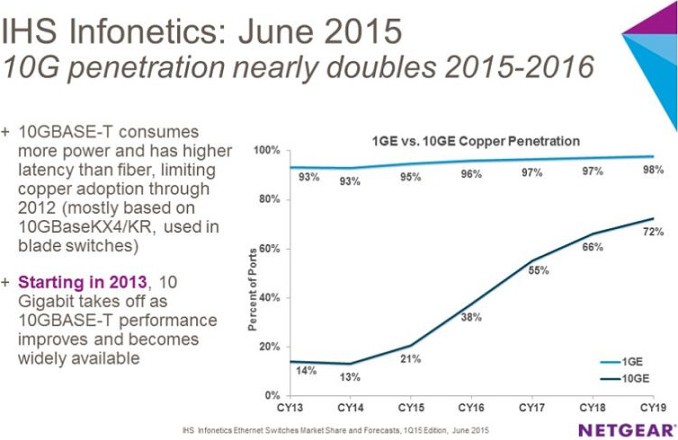Netgear Introduces Second-Gen ProSAFE 10GBase-T Switches for SMBs
by Anton Shilov on May 17, 2016 8:30 AM EST- Posted in
- Networking
- NetGear
- 10GBase-T

NetGear has introduced four new ProSAFE 10 GbE switches for small and medium businesses, upgrading their first generation of XS708E and XS712T parts. The new switches support both copper (10GBase-T) and fiber links, IPv6 management as well as Layer 2+/Layer 3 Lite features. NetGear claims that the new switches are significantly more cost-efficient than previous-generation 10 GbE products.
Internet speeds and file sizes increased orders of magnitude in the last ten years and for many offices (and prosumers), Gigabit Ethernet or basic teaming might no longer be enough. As a result, many businesses and individuals these days are evaluating migration to 10 Gigabit Ethernet, which of course has immediate high performance, but is more expensive on per-port basis than traditional GbE (as well as power consumption when looking for RJ45 compatibility). Fortunately, in the recent quarters, a number of companies have started to offer moderately priced 10 GbE switches supporting both copper and fiber links that can enable a more cost-efficient transition to 10 Gigabit networks.
The four new ProSAFE 10 GbE Smart Managed Switches from NetGear are the 8-port XS708T, the 16-port XS716T, the 24-port XS728T and the 44-port XS748T. The 8- and 16-port switches are based on single-core ARM Cortex-A9 600 MHz processor, whereas the more powerful 24- and 44-port models feature dual-core ARM Cortex-A9 800 MHz processor.
| NetGear ProSAFE 10 GbE Smart Managed Switches | ||||||
| XS708T | XS716T | XS728T | XS748T | |||
| 10GBase-T RJ-45 | 8 | 16 | 24 | 44 | ||
| SFP Ports | 2 shared | 4 dedicated | ||||
| CPU | Single-core ARM Cortex-A9 600 MHz | Dual-core ARM Cortex-A9 800 MHz | ||||
| RAM | 512 MB | |||||
| Non-Volatile Memory | 8MB SPI + 256 NAND | |||||
| Packet Buffer | 2 MB | 3 MB | ||||
| ACLs | 100 shared | 164 shared | ||||
| MAC Address Table RP/NDP Table VLANs |
16K MAC 738 ARP/NDP 256 VLANs |
16K MAC 1K ARP/NDP 512 VLANs |
||||
| Fabric Bandwidth | 160 Gbps | 320 Gbps | 560 Gbps | 960 Gbps | ||
| Rated Latency | 10GBASE-T: <3.012 μs SFP+: <2.466 μs |
10GBASE-T: <2.624 μs SFP+: <2.128 μs |
10GBASE-T: <11.649 μs SFP+: <2.619 μs |
10GBASE-T: <3.674 μs SFP+: <3.693 μs |
||
| Static Routes (IPv4 & IPv6) |
IPv4: 32 IPv6: 32 |
IPv4: 64 IPv6: 64 |
||||
| Multicast IGMP Group |
512 | |||||
| USB Port | One port for firmware and config access | |||||
| Rated Power Consumption | 49.5 W | 96.0 W | 134.9 W | 262.8 W | ||
| Price | $1558 | $2623 | unknown | $8198 | ||
The switches support modern VLAN features, such as protocol-based VLAN, MAC-based VLAN and 802.1x Guest VLAN; advanced QoS with L2/L3/L4 awareness and eight priority queues including Q-in-Q; dynamic VLAN assignment; IPv4 and IPv6 routing; IPv6 for management, QoS and ACL and so on. The devices come in rackmount form-factors and consume from 49.5 W to 262.8 W of power.
According to a survey of over 550 IT decision-makers in the U.S, U.K., and Germany ordered by NetGear and conducted by Palmer Research, approximately 33% of sub-500-employee businesses today already have 10 GbE switching to connect to modern 10 GbE servers and NAS. Meanwhile, a lot of those who currently do not use 10 GbE are considering to deploy it and plan to do so in the coming quarters. The survey says that by the end of 2017, 75% of the aforementioned organizations will have deployed a 10 GbE backbone by the end of 2017. Analysts from IHS (according to data provided by NetGear) seem to agree with the results of the survey and believe that adoption of 10 GbE is increasing rapidly these days.
Pricing of these switches are a lot higher than standard gigabit ethernet switches as 10GbE networks typically require the advanced management protocols for businesses and enterprise, whereas home users might be happy with a simple pass-through device. Because of the market, and the management requirements, we are still looking at above $150 per port for 10GbE. The NetGear ProSAFE XS708T and XS716T are available now for $1558 ($194.75 per port) and $2623 ($164 per port), respectively. The top-of-the-range XS748T will ship in July for $8198 ($186 per port). Pricing and availability of the XS728T were not touched upon by NetGear. By comparison, the popular first generation 8-port XS708E switch is retailing for $850 ($106.25 per port) at this point in its life cycle.
Sources: NetGear, ServeTheHome.












46 Comments
View All Comments
cm2187 - Tuesday, May 17, 2016 - link
When are we going to see laptops with 10GbE ports? It's nice to have a 10GbE infrastructure but not very helpful if we cannot consume it...DanNeely - Tuesday, May 17, 2016 - link
Probably never unless you count USB-C dongles. The thinner is better koolaid has murdered the RJ45 port.thetuna - Tuesday, May 17, 2016 - link
It's going to be quite a while before "workstation" type laptops stop carrying an RJ45.That said... I can't remember the last time I was inconvenienced by the speed of gigabit ethernet on my work laptop.
And pretty soon the wireless link on the laptop is going to be faster than gigabit anyway.
cm2187 - Tuesday, May 17, 2016 - link
> And pretty soon the wireless link on the laptop is going to be faster than gigabit anyway.Perhaps but right now we are much much much much much slower. I have never seen a wifi working at the advertised speed, even between two devices in the same room.
BurntMyBacon - Tuesday, May 17, 2016 - link
@thetuna: "I can't remember the last time I was inconvenienced by the speed of gigabit ethernet on my work laptop."Agreed. For most use cases, the end user link isn't what really needs to be 10G. At this point, I'd like to have 10G for uplinks between switches and 10G to my file server. Gigabit isn't really a problem with a single person accessing it, but multiple people accessing separate volumes on the file server can be bottlenecked by a single gigabit link to the file server.
@thetuna: "And pretty soon the wireless link on the laptop is going to be faster than gigabit anyway."
I wouldn't count on it any time soon. Even if you take the so called 2000Mbps routers at face value, you still need four antenna's to pull it off. Laptops don't generally have that and carrying around a dongle and a set of four antenna's seems even more burdensome than carrying an ethernet cable.
Of course, that's not the only issue. These speeds assume unidirectional traffic. As soon as traffic needs to go the other way, the transmitter has to transition to receiver (and vice versa). This kills more than half of your theoretical bandwidth for a balanced load. These speeds also assume the use of four adjacent 20MHz channels to make their so called 80MHz channel. As soon as another devices starts transmitting in any of the designated channels, your speed tanks as it tries to retransmit and reorder data. Having other devices connected is a problem as well as even small amounts of traffic can cause backoffs. There are technologies that could allow multiple devices to transmit on different channels simultaneously without interfering with each other, but again, the loss of these channels results in the immediate loss of the bandwidth associated with those channels. Of course, you loose even more if you make the devices share the channels aggregated as you encounter more backoffs and transmit to receive transitions. So I caution you not to get your hopes up.
azazel1024 - Tuesday, May 17, 2016 - link
In most cases full duplex doesn't actually kill more than half the bandwidth. Most router test out at slightly higher full duplex speeds than their half duplex.So a wifi router might hit something like 486Mbps in actual unidirectional speeds, but hit something like 500Mbps for bidirectional.
Since 80/160MHz is only used in 5GHz, there is rarely traffic that isn't your network on there due to 5GHz low penetration.
No, you don't hit real listed speeds, but in a supportive EMI environment close to the router, you can hit a reasonable fraction. My older Intel 7260ac with newer 802.11ac routers can easily net 76% payload through put on 2.4GHz, which is right at the theoretical limit (that missing 24% are acknowledgement and control packets, beaconing and forward error correction overhead).
On 5GHz, it isn't nearly as good, but it can still hit about 500Mbps with a tail wind, that is 57.6% of the signaling rate. I've seen wifi bridges between routers hit about 600Mbps for 2:2 802.11ac routers. That is 69% and probably also closer to where an even newer wifi client chipset can manage.
600Mbps doesn't "threaten" GbE, but it is still pretty fast and it was not obtained same room, that was through a wall and a bookcase. I'd imagine most newer 802.11ac 3:3 chipsets can hit a realistic 850-900Mbps or even somewhat higher. 4:4 802.11ac with 80MHz can absolutely saturate 1Gbps wired links (I've seen it in testing between AC2600 routers, I just don't have two to test with, just an AC1750 and an AC2600 and I've frankly never bothered to try out wireless bridges between them, just an AC1200 and AC1750 bridge, so 2:2 only).
We are inching up on 160MHz 802.11ac chipsets and 802.11ax isn't too far in the future, and that will likely see at least a real world increase of 50% in throughput with good EMI environment, maybe better.
Sooooo that said, we actually are probably just 2-4 years away from a gigabit Ethernet link slowing down network transfers with the latest and greatest wireless gear in good EMI environments (and I don't mean testing labs).
Still waiting on 2.5 and 5GbE gear. Been languishing in standards hell for the last couple of years with the promise of "coming really soon, we promise".
802.11ax https://en.wikipedia.org/wiki/IEEE_802.11ax
Schedule to debut 2019 and Huwai has obtained 10Gbps speeds in labs with pre-draft equipment. You'll need an even more ideal environment than you do now to see speeds like that, because of the very high modulation rate, but I would still expect to see real world 3-4Gbps speeds same room and 2+ next room over.
DanNeely - Tuesday, May 17, 2016 - link
Never mind 160, are there even any 80MHz channel products on the market?Personally, I'm hoping 80/160MHz channels are never implemented. There's only enough spectrum for 5/2 channels that large (with another 160 possible if we give up on a highspeed intercar communication network - wifi handshakes are too slow for opposing traffic on the highway). Enabling them would make the 5GHz band as clogged up with channel conflicts as the 2.4 GHz band is today.
azazel1024 - Friday, May 20, 2016 - link
Keep in mind how low penetrating 5GHz is. Sure, in an apartment situation, especially one with paper thing walls it would be a big issue...but in most typical apartment construction, let alone single family homes 5GHz conflict isn't an issue. In my rancher, I am getting <-90dB on the other side off the house from my basement router and vice versa with my upstairs access point. 2.4GHz on the other hand it is a low, but still viable -72dB or so. My house is not that big.or 80MHz channel products? Errm...all 802.11ac is at least 80MHz. I fit is running 40MHz, then it is running at reduced rate (200Mbps I think it 40MHz 256QAM?)
Daniel Egger - Tuesday, May 17, 2016 - link
> And pretty soon the wireless link on the laptop is going to be faster than gigabit anyway.No, very likely this will never happen, at least not for realistic data rates in real world usage scenarios. While 802.11ad potentially allows for >1Gbs sustained data rate, the use of 60GHz effectively means you will need to have line-of-sight to the communication partner and better do not have people crossing the LoS. Getting >1Gbs on 802.11ac is only possible on 5GHz with 160Mhz wide channels (not to be shared with any neighbour) and a crazy number of antennas (4 on each side should do) and of course LoS; in that case it just might be possible to get a real and sustained >1Gbs out of the Wifi link. It's important to realise that advertised speed or "capacity" is nowhere near the real speed...
rahvin - Tuesday, May 17, 2016 - link
You are smoking some good stuff if you think wireless is every going to surpass wired. I've yet to see a Gigabit wifi that can even come close to a sustained transfer on wired 1G. The only time they can even hit the theoretical rate is at 15 inches seperation in a faraday cage. In real world conditions AC can barely exceed 100mbit wired and it frequently can't sustain it for longer than a few seconds. Even then it takes 3-6 antennas, multi channel and a low noise floor. Things that will never be possible in a crowded urban environment.Maybe it will exceed it some day but honestly physics is against it ever happening. Wired will always be a step ahead. 10G copper will widely deploy when prices hit a threshold price just like 1G did. If you don't think 10G is going to deploy you aren't old enough to remember the transition from 10M to 100M to 1G. Prices just have to come down. The beauty of 10G over copper is that if your wire length is less than 30M you can probably already do it on Cat5e without a cable upgrade. Either way when switch prices come down to $100 for an 8 port you will see wide deployment of 10G copper.